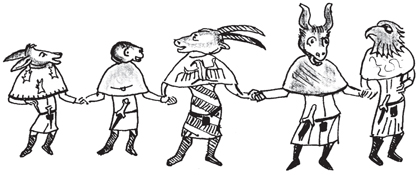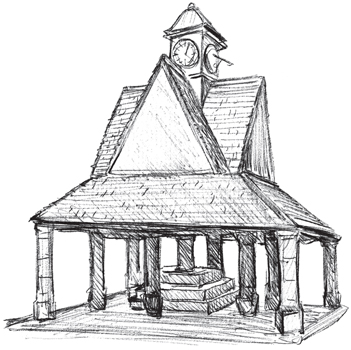Oxfordshire Folktales (16 page)
Read Oxfordshire Folktales Online
Authors: Kevan Manwaring
His father looked at him with astonishment, as did the whole room.
George held up ‘exhibit A’. ‘I cut it with my hatchet. I cannot say why exactly. It just happened. I am sorry, father.’
His father snorted in disbelief, looked around at the other adults, pointing at his son in amazement, and then his harsh expression melted into a smile.
‘Son, come here.’ He gathered his son up into his arms. ‘My son, that you should not be afraid to tell the truth is worth more to me than a thousand trees!’
From that day on George learned the value of living a truthful way and seeing justice done. Little did he know the seeds were sown that day for his future destiny: to become the President of the United States of America.
![]()
However apocryphal this tale, it is so famous and so charming, that it simply had to be included. A visit to Sulgrave Manor itself will bring alive Washington’s ‘backstory’ in a more factual way. What I find intriguing is the thought that some of his family’s servants might have taken part in the local Mummers’ Play – the text of which has survived – or that George himself might have witnessed it at Christmas-tide. On the 3rd of December 1992, the Sulgrave Mummers play was once again performed in the Great Hall of the Manor House, with parts played by members of the local history society. Since then, it has been revived in Northampton in an updated version by storyteller Jo Blake Cave and friends. The Mounts Mummers performed it on Christmas Eve 2011 around the town, culminating on the steps of All Saints’ Church; a modern, motley crew of characters (Molly; Duke of Cumberland; King George; Dr Parr; Jack Finney; Baalzebub; Bighead) akin to those George himself might once have seen in the grounds of his British ancestral home.

A S
TITCH
IN
T
IME
â T
HE
W
EAVERS
OF
W
ITNEY
Progress is not always a good thing. Things get smaller, faster, flashier â but at twice the price, and lasting half as long. Sometimes newer isn't always bestter, and something of the texture of life can be lost. In the Cotswolds, the warp and weft of community is strong in the old wool towns. Witney is one such place â proud of its weaving heritage and its world-famous blankets. Queen Anne appointed a weaver by the name of John White as the master of the Company of Blanket Weavers, granted a charter in 1711. Thomas Early assumed his mantle when he passed on â the Earlys had long been associated with weaving in the town. In 1669, Richard Early apprenticed his fourteen-year-old son, Thomas, to the woollen trade. Three hundred years later, their blankets were still being made and sold on both sides of the Atlantic.
The tradition of weaving has endured in Witney â like the family ties stretching back generations â but times change. The weavers of the town were not happy with the new technology which threatened their livelihoods. Faced with the spectre of unemployment, lacking the security blanket of the Welfare State â they took to sabotaging the machines that started to make their appearance in the early nineteenth century. The lives of the employers were threatened and riots broke out both in the streets and the fields â farmworkers equally besieged by the new machines. Yet the forces of progress and commerce could not be stopped.

In 1837, the waters of the river Windrush, which had turned the mills and scoured the wool for decades, was replaced with steam power.
In 1851, the Great Exhibition allowed John Early to show his skill to the world â a patterned blanket won him a Bronze Medal and a certificate signed by Prince Albert no less.
Yet another exhibition was causing greater interest; John Coxeter, a woollen merchant of Newbury, boasted that on his new-fangled machine (actually forty years old by that point) he could take a coat from a man's back, reduce it to wool and make it into a coat again, all within twenty-four hours â turning a coat into a coat, such is the wonder of progress! Sir John Throckmorton of Buckland approached Coxeter and asked if he could take the wool growing on a sheep's back at sunrise and make it into a coat by sunset the same day. He was willing to wager a thousand guineas on the project. Coxeter agreed to the challenge. On the morning of 25th of June 1811, Frances Druett, Sir John's shepherd, sheared two Southdown sheep as the sun rose, at 5 a.m. Eleven hours later, the dyed cloth was ready to be cut by James White, the son of a Newbury tailor. Nine men were waiting with needles threaded and by twenty minutes past six the coat was finished, with one hour and forty minutes left before sunset. That evening, Sir John dined with forty of his friends at the Pelican Inn at Speenhamland, wearing his fine new coat.
The Earlys of Witney challenged this record in 1906, when, on the 8th of June, sheep were shorn at sunrise, and ten hours and twenty-seven minutes later the blankets were completed, embroidered with a ducal âM' and presented to the Duke of Marlborough. John Coxeter's record was finally broken, after nearly a century.
With the advance in technology further wonders were possible.
On the tercentenary of Thomas Early's apprenticeship (three hundred years earlier), on 11th of June 1969, they set about breaking their own record in Transatlantic style. At 4 a.m., one hundred and fifty Kerry Hill sheep were sheared. The wool passed through the necessary processes in record time, and the first blanket was ready at 12.11 p.m., eight hours and eleven minutes after shearing.
Before evening, fifty blankets were completed, one of which was flown to New York in time to be displayed with the notice: âThe wool of which this blanket is made was shorn from sheep at Witney, England, this morning.'
It was not the first time that Witney blankets had crossed to the New World â Native Americans were fond of them, notably the Indians of Virginia and New England, who liked the red and blue dyes. They would tear off suitable lengths, make two holes for their arms, and wrap the remainder around their bodies. In exchange, they brought furs to the English traders. Whether these Witney blankets contained the smallpox that decimated their population is not known.
*Â *Â *
Time flows on. The weaving industry floundered through the twentieth century and by the end was threadbare. Some filaments remain, but it is a shadow of its former glory. Now it is cheaper to import fabrics made in the sweatshops of China; ship them halfway across the world, like that transatlantic record-breaking attempt â but at what cost to the Earth? Perhaps these cheap fabrics carry with them their own kind of âsmallpox', decimating local industry and destroying communities. Yet some are realising the value of the local, the handmade, the ethically-sourced and lovingly crafted â as opposed to the mass-produced and shoddy.
Visit a Farmers' Market in the area these days, and you'll see stalls selling all kinds of fine wares. The looms and wheels are still at work in the homes of traditional artists. Perhaps the Fates have spared this particular thread.
Here's to the homespun; and to weaving the threads of life. Long may wool be gathered on the Cotswolds!
![]()
Wool was once the linchpin of the Cotswold economy; many of the towns developed as a result of its value, and Witney's story is not unique, however much the accomplishments of its inhabitants might be. Although the people of Witney have been trading in wool as far back as the Iron Age, it was the medieval period that really saw the wool trade boom. They truly believed that the secret to their success was that they had sheep that were a cross between the Iron Age sheep and a breed that the Romans brought to Britain resulting in long, fine wool, the quality of which made exporting easy. The land along the nearby Windrush River was used for bringing up sheep and the water helped in the many processes in cloth making. Witney also had good road networks to trading centres. Now we live in far more connected times, and the procurement of goods from overseas is not seen as anything special, indeed, it has become the norm â often to the detriment of the local economy. Yet it seems, once more, that people are valuing the local and hand-made in the many splendid markets and craft shops across the region.
![]()
M
OWING
Y
ARNTON
M
EADOWS
I remember the Mowing Fair from the meadows of summer as though it was yesterday. Old Gran Joan you may know me as, and a grandmother I’ll always be to your strong eyes, but when the sun is on the grass I still feel like a little girl inside. Listen close, and I’ll tell you my tale…
Once-a-time, the lush meadow of Yarnton was the scene of great festivity in July of each year. The whole village throbbed with excitement. It was the time for the drawing of lots for the common land, and the Mead Balls were used for this venerable custom. I might look old to you young pups, but these Mead Balls were the oldest relics in the village even then. Once, many a meadow had them, but now they seem to be the only surviving ones in England these days. Small, hard and tough – like me! – they have managed to survive. They were used when the Domesday Book was writ. Thirteen balls, made of a light wood – probably holly, one inch in diameter, worn smooth with constant handling – you could hold them in the palm of your hand. Look close and you’ll see names scrivened on them – Boat, White, Dunn, William, Water Molly, Green, Boulton, Rothe, Gilbert, Harry, Freeman, Walter Jeoffrey and Parry – tenant farmers with mowing rights in the meadows. How far back they go, no one knows.